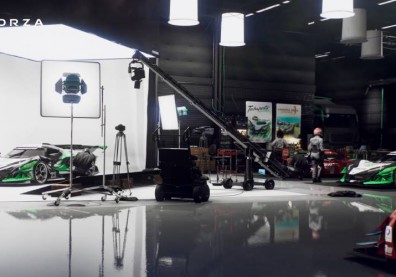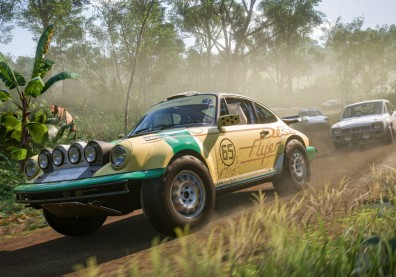Microsoft and Turn 10 Studios has announced February's car pack add-on for its open-world arcade racer Forza Horizon.
This month's Jalopnik car pack will included six cars and will be available on Xbox Live for download on Feb. 5 for 400 Microsoft Points. For those who have purchased the Forza Horizon Season Pass, the new car pack will be available for free.
The Jalopnik car pack includes the 1970 Nissan Datsun 510, 2012 Toyota FJ Cruiser, 2013 Subaru BRZ, 1991 Ferrari 512 TR, 1973 Mazda RX-3 and 1966 Ford Country Squire.
Here is a look at the new cars from the official announcement on the Forza Horizon website:
1970 Nissan Datsun 510: Practicality and appeal have rarely met more successfully than in the Datsun 510 series. Its inspired design is revered among import enthusiasts worldwide. The 510 proved its race chops with off-road and on-track success in the early 1970s, including the 1970 East African Safari Rally and competitive finishes in the U.S. Trans Am series in 1971 and 1972-where it won the under 2,000 cc class. Early on owners built up their 510's in the image of the race-winning cars which, in part, inspired today's "Stance" culture.. The 510's influence is still felt today and, due to its popularity and easy upgradeability, it is rare to find a stock model these days. Build one in Forza Horizon then take to the roads or rally circuit to experience the joy of this JDM icon.
2012 Toyota FJ Cruiser: So many SUV's have gone the way of becoming luxurious coaches. Sure, they can go offroad, but that doesn't mean they look comfortable doing it. Not the FJ Cruiser! It was cast in the mold of its ancestor-- the legendary FJ40 Land Cruiser--with off-road capability at the forefront of its design. The FJ will take you places few other SUVs would dare to tread and it does so in style and comfort. Whether in town or on the highway, it is no lumbering beast. The FJ is well-mannered and its unique retro functional form will always attract attention. Taken off-road its best-in-class ground clearance and mighty approach and departure angles let the FJ articulate its way over most obstacles with ease. It is at home on the trail but is equally welcome to travel about town in rugged grandeur.
2013 Subaru BRZ: As the phenomenally successful collaboration between Subaru and Toyota, the BRZ has been met with widespread critical acclaim and manic consumer demand. This is a classy, adept, and (with much thanks) rear-wheel drive sports car that puts the emphasis on sports. The BRZ is powered by a new Subaru-designed naturally aspirated flat-four that makes 200 horsepower and screams right up to its 7,400 rpm redline. Keeping the overall weight down and distributing that weight as close to the ground as possible were design priorities. The result is a low-slung and well-balanced disposition. Is the BRZ driftable? Absolutely! Can it also corner predictably and inspire confidence? Indubitably. In fact, complementing its potential as a spirited daily driver, the BRZ is ready for the track. According to Subaru, enough trunk space for a set of race wheels and a toolbox was built into the design from the start.
1991 Ferrari 512 TR: Whether you call it the replacement for the Testarossa or simply the next evolution, the 512 TR iterates on one of the Prancing Pony's most celebrated models. Literally, the 512 TR stands for five-liter, twelve-cylinder Testa Rossa. For 1991 its sculpted curves were enhanced, and the nose and rear valance treatments were updated. The most significant improvement, although not visually apparent, was the lowering of the engine and transmission. Handling, already exceptional, was improved to an even higher standard. For 1991, a 4.9 liter, 180-degree, 12 cylinder with four valves per cylinder delivered increased horsepower for a total output of 421 horsepower for U.S. models. Visually stunning with performance to match, the 512 TR should be a welcome addition to any collection.
1973 Mazda RX-3: The evolution of the Japanese sports car is evident throughout the Mazda RX-3's history. It is similar in body style to the Nissan Skyline and Toyota Celica of its era, but that is where the similarities end. Mazda's "Wankel" or rotary motor is a far cry from typical cylinder-driven motors. The internal rotors convert pressure into rotating motion and deliver smooth high-rpm power. For 1973 in the U.S. the RX-3 came with the larger 12A motor that made a healthy 90 horsepower. In a car weighing less than 2,000 pounds, the power-to-weight ratio made the car agile and fairly quick. It could be said the RX-3 is the nemesis of the Skyline, since it won the touring car category of the Japanese Grand Prix in 1972 and prevented the GT-R from winning 50 races in a row. The RX-3 was successful on and off the track placing fifth overall in the 1975 Bathurst 1000 and winning its class two years in a row. The RX-3 remained in production until the design was reconceived as the RX-7.
1966 Ford Country Squire: Emulating the original look and feel of the real woody sedans and wagons of the 1950's, the 1966 Country Squire was adorned in fiberglass paneling with a vinyl decal printed to simulate wood. This family truckster was standard fare for middle America in its day and was commonly purchased with a rear-facing third seat. It is obviously designed for families and hauling kids around, but its 315 stock horsepower is no slouch in the giddy up department. Weighing in at more than 4,000 lbs., you can really swing your weight around the roads of Horizon's Colorado. Even though drifting may never have been in the minds of their original owners, there is something special about getting sideways in a Country Squire.
2010 Devon GTX-February Season Pass Bonus Car: The Devon GTX targets those who are willing to pay a premium to drive something unique and exclusive. With a price tag of more than a half-million dollars, exclusivity is guaranteed. As for uniqueness, the GTX certainly has that market cornered. Underneath the gullwing doors and smoothly contoured carbon-fiber body is the core of the Dodge Viper. Devon has massaged 50 more horsepower out of the 8.4 liter V-10 and upgraded the suspension and braking. Performance testing at Laguna Seca resulted in lap times just a shade lower than those set by a Viper ACR. Whether gaining a few tenths of a second per lap (and the ability to make even the most posh heads turn) are worth four times the cost of a standard Viper is a decision most of us will never have to make.
Check out the new trailer...









